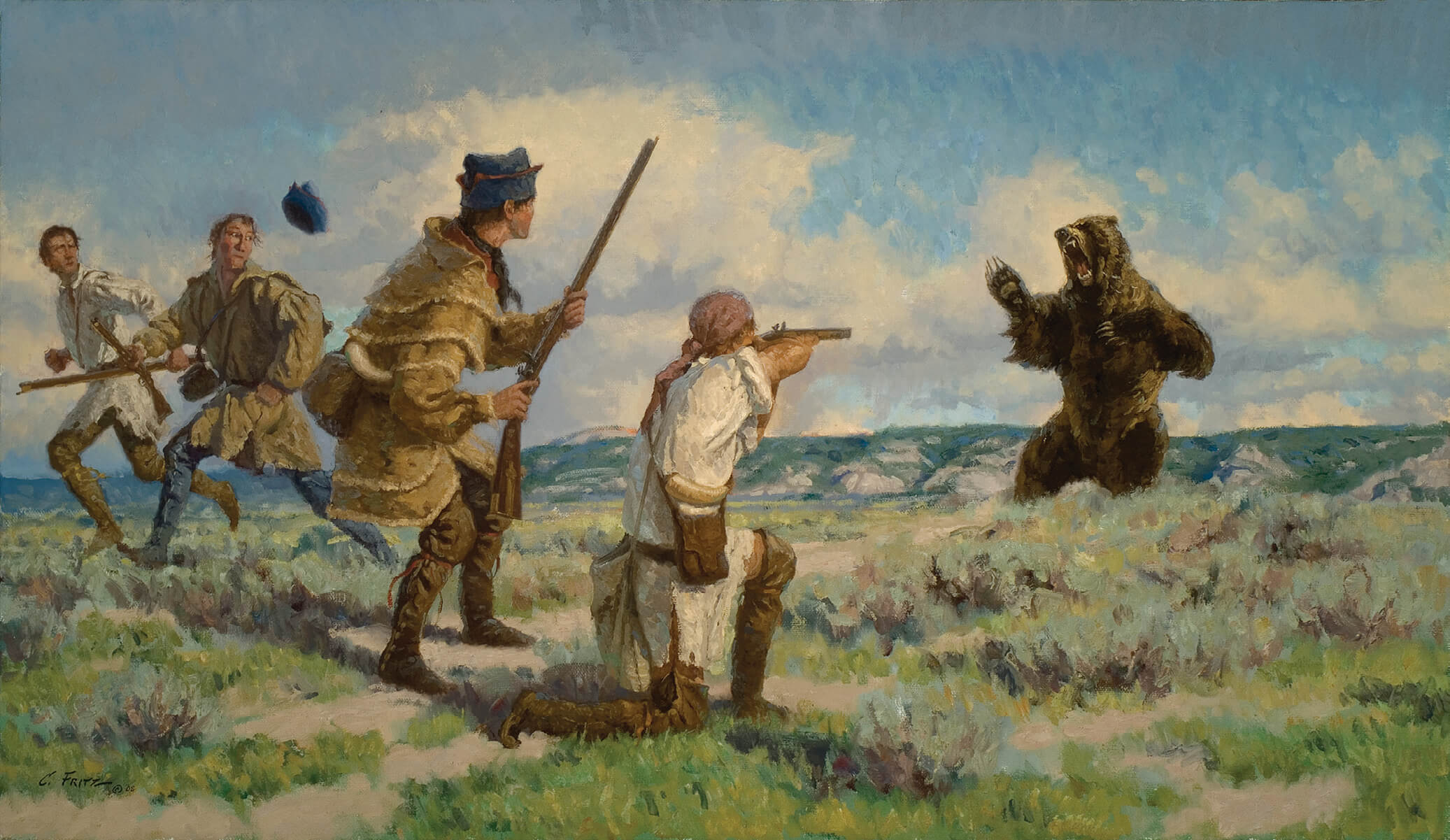
24 Nov A Path of Discovery
Montana had no official eastern boundary in 1805, because the state as we know it did not exist. The confluence of the Yellowstone and Missouri rivers served the purpose well enough then, as it nearly does today. The Lewis and Clark expedition reached that landmark in April of 1805, after an arduous year-long journey across the plains from the starting point in St. Louis. Shortly after making camp, the explorers experienced a life-changing encounter with a grizzly bear.
They were already aware of the grizzly and its reputation, thanks to tracks and Native lore. As Lewis had written two weeks earlier:
We have not yet seen one of these animals, though their tracks are so abundant and recent. … The Indians give a very formidable account of the strength and ferocity of this animal, which they never dare to attack in parties of less than eight, or ten persons; and even then they are frequently defeated.

Rocky mountain bighorn sheep | May 29 | The subsequently described Audubon bighorn was likely the same animal.
The expedition members’ initial contact with the species — which they distinguished from the familiar black bear by referring to it as the yellow, white, brown or, eventually, “Grisely” (Clark’s spelling) bear — did little to dispel this impression. In an April 29 journal entry, Lewis describes encountering two grizzlies, shooting and wounding one, and being pursued for 70 or 80 yards before dispatching it.
During the expedition, Lewis and Clark identified and described over a hundred fish, birds, reptiles, and mammals previously unknown to Western science. Thirty-two of those “discoveries” took place in what is now Montana. Of those, the grizzly was both the first and, arguably, the most dramatic.

Yellow-haired porcupine | May 3 | Among the world’s rodents, this porcupine is exceeded in size only by the South American capybara and our familiar beaver.
Few events in the history of the American West have been described more thoroughly than the Lewis and Clark expedition. This essay limits its focus to their sequential record of previously undescribed vertebrates on their outbound trip across Montana. While these are often described as “discoveries,” I placed the term in quotation marks earlier for a reason; the region’s Native population was obviously familiar with these animals and no doubt knew more about them than the expedition leaders ever would. What Lewis and Clark offered was not discovery, but the first written descriptions for biological science.
What has always impressed me about the accounts recorded in Lewis and Clark’s journals is their remarkable accuracy and the degree to which the writings have withstood the test of time. These descriptions were very much part of the expedition’s mission since Jefferson, a visionary figure despite his later deconstruction as a slave owner, was as interested in the new territory’s natural history as its geography and political significance to the young nation.

Western Meadowlark | June 22 | His ability to distinguish this bird from the familiar eastern meadowlark is a tribute to Lewis’ power of observation.
One early criticism of the expedition’s structure was that it lacked a “trained biologist.” After its conclusion, many highly regarded authorities in the field would parse these observations, argue about their significance, study the specimens brought home, reclassify many species and subspecies, and claim some of these discoveries as their own. However, I find it hard to imagine that any of these educated biologists could improve upon the descriptions that Lewis and Clark recorded in their journals, while working under the challenging conditions they faced in the field.
How many new species did Lewis and Clark describe on their journey? It is hard to provide a definitive answer, since virtually every “trained biologist” who examined the records seemed to come up with a different number. Some of these discrepancies were inevitable as species became reclassified as subspecies and others (but not many) were rejected outright. The fact that the expedition leaders never had an opportunity to summarize their own data doesn’t help. A reasonable estimate based on multiple sources is around 100 fish, birds, reptiles, and mammals, of which around 30 were first described in Montana. The list also includes over 100 species of plants, which are not addressed herein because of space constraints (and my own lack of botanical knowledge).

Lewis’s Woodpecker | July 19 | Of all the wildlife species discussed herein, this may be the least likely to encounter casually.
Shortly after their chaotic encounter with the bear, Clark reported observing another of Montana’s iconic large mammals, which he and Lewis referred to as the “big-horned animal” in their journals. The animal in question is now known as the Rocky Mountain bighorn sheep, one of two species (with multiple subspecies) of wild sheep whose ancestors crossed the Bering Sea land bridge into North America thousands of years earlier. Although Lewis and Clark saw sheep frequently as they proceeded along the Missouri, they were not able to obtain a specimen until Clark shot one on his return trip up the Yellowstone the following year.
Subsequent study of the bighorn provides an interesting illustration of the difficulties posed by classifying the wildlife Lewis and Clark described. In 1843, famed naturalist and painter John James Audubon retraced the expedition’s route up the Missouri to study large mammals. He encountered the bighorns, which he considered distinct from those in mountainous terrain farther west. Based on Audubon’s descriptions, these sheep became recognized as a distinctive subspecies called the Audubon bighorn, and Lewis and Clark were credited with its first description. By the early 1900s, this sheep population had been extirpated by unregulated subsistence hunting, to the consternation of biologists and conservationists alike. However, later genetic studies established that these sheep were identical to bighorns in mountain habitat farther west — Lewis and Clark had been credited with discovering a “species” that probably never existed. (In fairness, controversy still exists over the Audubon bighorn’s genetics.)
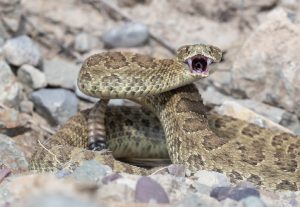
Prairie Rattler | May 30 | The rattler is the only venomous snake native to Montana.
I have long been uncomfortable with our natural tendency to focus attention on large, glamorous species that are no more important to the ecosystems they occupy than all the less obvious ones at the base of the food chain. Why, for example, are so many people concerned about whales, while ignoring the krill without which the whales couldn’t survive? While I might seem guilty of the same flawed reasoning here, the grizzly bear and the bighorn sheep really were the first two new species Lewis and Clark described after reaching the Montana border. Fortunately, they were not the last.
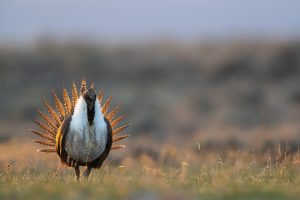
Sage Grouse | June 10 | This male is in full display on a spring lek.
Near the Great Falls of the Missouri, Lewis and Clark described several fish that remain familiar today. During the trip upstream, their powers of observation hardly lay dormant. Shortly after leaving the mouth of the Yellowstone, they encountered and described the yellow-haired porcupine (the world’s third largest rodent) near the mouth of a creek entering the Missouri from the north. The animals were present in such numbers that they named the stream the Porcupine River, although it is the Poplar River today. While exploring the Marias River in early June, Lewis observed what he called the “Cock of the Plains,” now known to us as the sage grouse. Today, the continent’s second largest gallinaceous bird is the subject of concern because of population declines due to habitat fragmentation and degradation. In between porcupines and grouse, the explorers recorded first descriptions of McCown’s longspur; several snakes, including the prairie rattler; and the willet, a medium-sized shorebird often observed today near shallow prairie wetlands.
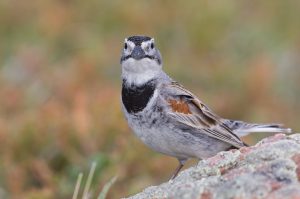
McCown’s Longspur | June 10 | Longspurs often elude even the most serious of birders’ life lists.
Between the Marias River and the Great Falls, they encountered both the sauger, a popular gamefish often confused with the walleye; and the goldeye, an aggressive little silvery fish that, when smoked, eventually became a dining-car staple on the Canadian Pacific Railway. Although often overlooked by anglers today, the goldeye remains popular among light-tackle dry-fly fishermen. On June 12, Lewis described himself as amused, “catching those white fish mentioned yesterday. They are here in great abundance. I caught upwards of a dozen in a few minutes.” Even allowing for inevitable angler exaggeration, that’s good fishing, and I felt delighted to learn that Lewis wasn’t too busy to enjoy it.
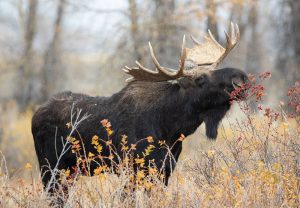
Shiras Moose | June 7 | The Shiras is the only one of three recognized North American moose subspecies found exclusively in the lower 48 states.
Perhaps their most significant fish discovery east of the Continental Divide also came from the Great Falls, on June 13, courtesy of Private Silas Goodrich, the expedition’s most accomplished angler. As Lewis reported:
Goodrich had caught half a dozen very fine trout. … [T]hese fish (caught in the falls) are from sixteen to twenty-three inches in length, precisely resemble our mountain or speckled trout in form and the position of their fins, but the specs on these are of a deep black instead of the red or gold color of those common to the U. States. They … have generally a small dash of red on each side behind the ventral fins.
Lewis’ “mountain or speckled trout” is almost certainly the familiar eastern brook trout and the new fish he describes were cutthroats, the only trout native to Montana. Except for a mistake in the location of that “small dash of red,” which lies on the lower jaw, that description is quite accurate. Biologists have argued over cutthroat nomenclature and subspecies distinctions for years, but these fish probably belonged to the westslope subspecies, even though they were caught on the east side of the Continental Divide. Ironically, cutthroats wound up as Oncorhynchus clarkii even though Clark was apparently out buffalo hunting when Goodrich pulled the species prototype from the Missouri.
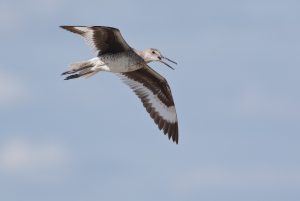
Willet | May 30 | This common wader is easily identified by its white wing bars in flight.
These three observations were the expedition’s last encounters with novel fish until the party crossed the Continental Divide. Before leaving the Great Falls area, however, they described several new mammals (the kit fox, pack rat, and Shiras moose) and birds (the long-billed curlew and Brewer’s blackbird). Then, having already described what is today recognized as the state mammal (the grizzly) and state fish (the cutthroat trout), they rounded out the Montana trifecta when, on June 22, Lewis reported:
There is a kind of larke here that much resembles the oldfield lark with a yellow breast and a black spot on the croop; tho’ this differs from ours in the form of the tail which is pointed being formed of feathers of unequal length; the beak is somewhat longer and more curved and the note considerably different.

Cutthroat Trout | June 13 | The cutthroat is the only true trout (as distinct from char) native to Montana.
Lewis was describing the western meadowlark, now Montana’s state bird. Note his ability to appreciate the subtle differences in appearance and voice that distinguish it from its familiar eastern counterpart (presumably the “oldfield” lark). Today’s bird watchers find that difference difficult to confirm, even with modern binoculars.
One more wildlife observation made before they crossed into what is now Idaho warrants particular attention. As the party headed south toward the Missouri headwaters at Three Forks on July 20, Lewis wrote:
[S]aw a black woodpecker (or crow) today, about the size of the lark woodpecker, as black as a crow. … [I]t is a distinct species of woodpecker; it has a long tail and flies like a jay bird … [the breast and belly are] a curious mixture of white and blood red which has much the appears of having been artificially painted or stained that color.”
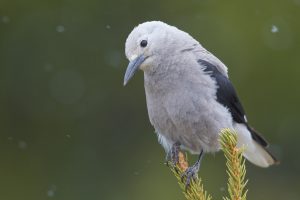
Clark’s Nutcracker | August 22 | The Clark’s nutcracker is the only bird species named for Captain Clark.
This bird, the Lewis’s woodpecker, is not an everyday species. Although I don’t live in its prime range or habitat, I do spend a lot of time outdoors looking at birds, and I have only seen one during my 50 years in Montana. Its appearance is striking, and Lewis provided as accurate a description of its odd coloration as any I’ve ever seen.
This observation is significant in another way, since it is the only example of Lewis’ name being attached to one of his discoveries — an oddity in the field of ornithology, which is riddled with eponyms. Clark got just one bird, too: the Clark’s nutcracker, which he described in August as the expedition moved west through Idaho. (The Clark’s grebe is named after another Clark.) In both cases, the birds received their current common names from “trained naturalists” studying their records and specimens long after Lewis and Clark returned home.
Readers interested in a complete record of the expedition’s contributions to science shouldn’t stop at the Montana border. In fact, the leaders made far more biological discoveries after they crossed the Divide, especially during the brutal winter of 1805–6, which they spent at Fort Clatsop, on the Pacific Coast. I can see two reasons for this discrepancy: The Pacific Coast was new territory rife with unique wildlife, and they were operating out of a fixed basecamp, giving them more time to explore and observe. They also recorded far fewer wildlife observations during their return than they did during the outbound leg of the expedition. Having spent long periods of time in the wilderness myself, I suspect that they just wanted to get home to a hot bath and a cold beer.
Readers will note that almost all the observations described here came from Lewis, who was clearly the one with the greater interest in natural history. As Jefferson wrote before the expedition began, Lewis had “a talent for observation which had led him to an accurate knowledge of the plants and animals in his own country.” Lewis intended to write a summary of these observations that he never produced, making his premature death in 1809 (either by murder or suicide — historians remain divided) an especially great loss to science.
The Lewis and Clark journals have been condensed and edited by many historians in many ways. I recommend the John Bakeless edition (Signet, 1964), which should be required reading for all who live near or visit the route of their journey. Paul Russell Cutright’s Lewis and Clark: Pioneering Naturalists (University of Nebraska Press, 1989) is another valuable resource.




Landon Jones
Posted at 19:33h, 01 FebruaryExcellent article. Please do note that the most recent John Bakeless edition of the Lewis and Clark journals was published by Signet in 2011 with an Afterword by Landon Y. Jones.